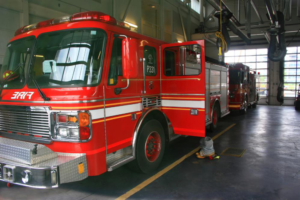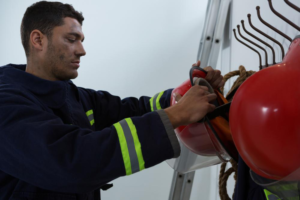
- admin
- June 27, 2020
- 3:48 pm
- No Comments
Simple Steps Firefighters Can Take When Tackling Crisis on the Front Line amid COVID-19
Firefighters belong to one of the most highly rewarding, yet most dangerous professions. They’re at risk of various types of injuries and burns while on duty, making their job all the more life-threatening. In 2020, firefighters across the United States have been met with yet another challenge: the coronavirus. They’ve been part of the first responders who attended to the first several cases, and have continuously been involved in the fight against the virus ever since.
As of April 2020, 12,742 first responders, including firefighters, had been affected by the coronavirus, and 686 had tested positive. These numbers have increased dangerously in the months since, with several more firefighters having contracted the disease in the line of duty.
There’s no underplaying the role of firefighters in the battle against the pandemic. They’ve been at the frontlines in all kinds of crises, making hazmat calls whenever there’s been a CBRNE incident. Amid the coronavirus crisis, they’ve been working tirelessly to deliver food & medical supplies, drive ambulances, and conduct other essential public services to help their communities.
The high-risk job has become even riskier for firefighters during the pandemic, and yet, it’s one that needs to be done. This is why it’s so important for them to adhere to strict precautionary measures and implement certain preventive rules when on the job. Here’s how firefighters can reduce the chances of getting infected when providing their services on the frontline amid COVID-19.
Limit Contact
One of the biggest changes firefighter units should implement is limiting contact with people. Typically, more than just a handful of squad members would be sent out during a response call. With the coronavirus threat, however, this is no longer a feasible option. Social distancing is necessary to contain the spread of the virus, and that means sending out the whole platoon is a risky thing to do.
 Many firefighter units across the country have already adopted this policy by limiting the emergency responders sent out on specific missions. For example, many units now send a two-person ambulance crew if they are to enter the home of an individual who has tested positive for COVID-19, has recently interacted with someone who has the disease, or is showing symptoms. When responding to calls, firefighters first ask detailed questions to determine whether or not the house they’ll be entering poses a risk of coronavirus, and plan their trip accordingly. As per the recommendation of health authorities, some social distancing is practiced when interacting with individuals.
Many firefighter units across the country have already adopted this policy by limiting the emergency responders sent out on specific missions. For example, many units now send a two-person ambulance crew if they are to enter the home of an individual who has tested positive for COVID-19, has recently interacted with someone who has the disease, or is showing symptoms. When responding to calls, firefighters first ask detailed questions to determine whether or not the house they’ll be entering poses a risk of coronavirus, and plan their trip accordingly. As per the recommendation of health authorities, some social distancing is practiced when interacting with individuals.
Contact should also be limited at the stations. Instead of having a group of firefighters share the facilities at the same time, shifts should be broken down further to prevent a large gathering in the premises. The squad should also make limited trips to stores or other public places to prevent the risk of contamination.
Implement Screening Calls & Donning PPE
Since firefighters conduct a thorough screening of the individuals they’ll be attending to before heading out for the call or coming in close proximity with them—for instance, if the caller complains of shortness of breath, reports having a mild fever, or mentions any other COVID-19 symptoms—they’ll need to don PPE in addition to other protective gear.
 When making EMS calls, patients should be asked to walk outside a safe distance to meet the firefighter crew and receive the supplies, if they’re easily able to do so. If they’re not, then the personnel entering the building will need to be covered with PPE and make a quick entry and exit to minimize contact. PPE typically includes a disposable gown, gloves, eye protection, and a NIOSH-approved N95 respirator to prevent the transmission of the virus.
When making EMS calls, patients should be asked to walk outside a safe distance to meet the firefighter crew and receive the supplies, if they’re easily able to do so. If they’re not, then the personnel entering the building will need to be covered with PPE and make a quick entry and exit to minimize contact. PPE typically includes a disposable gown, gloves, eye protection, and a NIOSH-approved N95 respirator to prevent the transmission of the virus.
Shift to Online Training
It’s important to continue with the necessary training sessions even with the pandemic. In fact, the new and unpredictable situation calls for even more attention toward strategy development and staff training. However, conducting these training sessions physically with dozens of firefighters present in one location is dangerous and goes against the social distancing laws that need to be strictly enforced.
 This is where online training sessions can come handy. With so many businesses opting to work remotely ever since the pandemic struck, teleconferencing and online communication have been imperative for all industries. While the training exercises conducted online can’t be exactly the same as those conducted on-ground, they can be modified to include as much information and expertise as possible.
This is where online training sessions can come handy. With so many businesses opting to work remotely ever since the pandemic struck, teleconferencing and online communication have been imperative for all industries. While the training exercises conducted online can’t be exactly the same as those conducted on-ground, they can be modified to include as much information and expertise as possible.
Sanitize ALL Equipment
This cannot be emphasized enough. All equipment used by firefighters during and after rescue missions and calls should be thoroughly sanitized and sterilized. This includes vehicles, shared tools, and protective gear.
In addition to this, care must also be taken to disinfect the various surfaces within the fire department. Bunk beds, doorknobs, light switches, benches and other surfaces that are touched frequently by the staff should be cleaned properly a few times every day.
Join the Nation’s Bravest Force
Being a firefighter is a highly esteemed and satisfying job. When you sign up for this force, you aren’t just protecting individuals from fires and related accidents, but are at the frontlines in times of all kinds of crises. Firefighters take it upon themselves to deliver public services to those who need them the most, risking their own lives in the act.
Getting into the firefighter squad is no piece of cake. If you wish to join the prestigious NYC Firefighter Department, you’ll first have to clear the FDNY exam.
Civil Service Success helps aspiring candidates prepare for the NYC firefighter exams through their prep classes for civil services. We offer training sessions, expert advice and tips, and an abundance of resources to our students to help them ace the exam and get ranked high on the waiting list issued each session.
For more information about our online sessions, call at 631-218-0889 or visit our website to check when registration opens for this exam.

